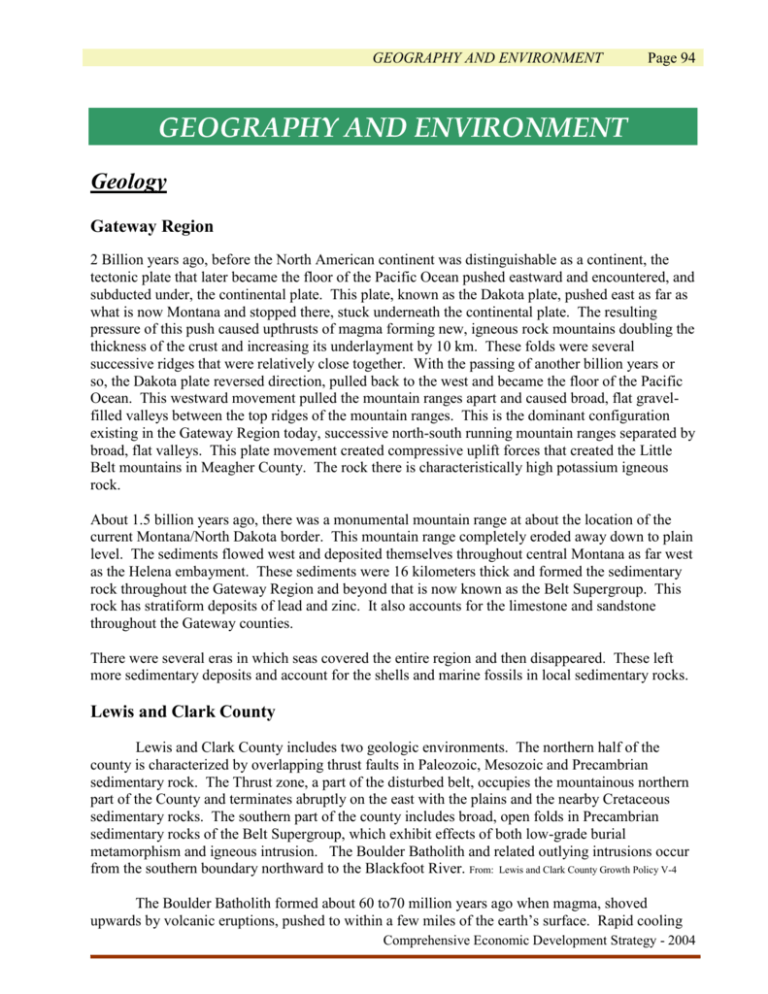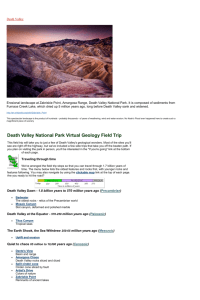Geography and Environment
advertisement

GEOGRAPHY AND ENVIRONMENT Page 94 GEOGRAPHY AND ENVIRONMENT Geology Gateway Region 2 Billion years ago, before the North American continent was distinguishable as a continent, the tectonic plate that later became the floor of the Pacific Ocean pushed eastward and encountered, and subducted under, the continental plate. This plate, known as the Dakota plate, pushed east as far as what is now Montana and stopped there, stuck underneath the continental plate. The resulting pressure of this push caused upthrusts of magma forming new, igneous rock mountains doubling the thickness of the crust and increasing its underlayment by 10 km. These folds were several successive ridges that were relatively close together. With the passing of another billion years or so, the Dakota plate reversed direction, pulled back to the west and became the floor of the Pacific Ocean. This westward movement pulled the mountain ranges apart and caused broad, flat gravelfilled valleys between the top ridges of the mountain ranges. This is the dominant configuration existing in the Gateway Region today, successive north-south running mountain ranges separated by broad, flat valleys. This plate movement created compressive uplift forces that created the Little Belt mountains in Meagher County. The rock there is characteristically high potassium igneous rock. About 1.5 billion years ago, there was a monumental mountain range at about the location of the current Montana/North Dakota border. This mountain range completely eroded away down to plain level. The sediments flowed west and deposited themselves throughout central Montana as far west as the Helena embayment. These sediments were 16 kilometers thick and formed the sedimentary rock throughout the Gateway Region and beyond that is now known as the Belt Supergroup. This rock has stratiform deposits of lead and zinc. It also accounts for the limestone and sandstone throughout the Gateway counties. There were several eras in which seas covered the entire region and then disappeared. These left more sedimentary deposits and account for the shells and marine fossils in local sedimentary rocks. Lewis and Clark County Lewis and Clark County includes two geologic environments. The northern half of the county is characterized by overlapping thrust faults in Paleozoic, Mesozoic and Precambrian sedimentary rock. The Thrust zone, a part of the disturbed belt, occupies the mountainous northern part of the County and terminates abruptly on the east with the plains and the nearby Cretaceous sedimentary rocks. The southern part of the county includes broad, open folds in Precambrian sedimentary rocks of the Belt Supergroup, which exhibit effects of both low-grade burial metamorphism and igneous intrusion. The Boulder Batholith and related outlying intrusions occur from the southern boundary northward to the Blackfoot River. From: Lewis and Clark County Growth Policy V-4 The Boulder Batholith formed about 60 to70 million years ago when magma, shoved upwards by volcanic eruptions, pushed to within a few miles of the earth’s surface. Rapid cooling Comprehensive Economic Development Strategy - 2004 GEOGRAPHY AND ENVIRONMENT Page 95 stopped the upflow and caused crack and fissures. Into these cracks and fissures flowed mineralized solutions containing copper, gold, silver and other precious metals. The batholith itself is granite (quartz monzonite) containing mineral deposits in the cracks and fissures. This is the mineral wealth that was so important in the early economy of the western Broadwater County and the southern and western portions of the Helena valley. From: “Basking in the Boulder Batholith,” 2003, by George Everett, www.butteamerica.com/batholith The Helena valley lies at an elevation of 3,650-4,000 feet for about 65 square miles, and continues to the Continental Divide at elevations of 6,000 to 8,000 feet. A significant feature of the Helena valley is the Missouri River Canyon below Hauser Dam. Devil’s Elbow, a feature along the Missouri River described in the Journals of Lewis and Clark lies in the Helena Valley area. The Spokane Hills and the south Hills rise to a level of 4,500-5,600 feet on the southeast end of the valley. Mount Ascension is at 5,365 feet on the east, and to the west Red Mountain rises to 8,150 feet. There are quartzite deposits throughout the area which sparked the gold mining boom of the 1860’s through 1890’s. West of Helena is a one-time marble quarry. Sapphires are found at Eldorado Bar. They were used for instrument bearings in WWII. Currently a slate quarry is operating at the Gates of the Mountains, Gates Slate. There is some low quality Bentonite that may be useful as pond liner and for reclamation projects. (information from Dick Berg, Montana Bureau of Mines) The Helena Valley is located within the Intermountain Seismic Belt; a seismically active zone associated with major geologic fault structures. The Helena valley has a long history of seismic activity with the most severe recorded earthquakes occurring in 1935 measuring up to 6.3 on the Richter scale. A large part of the Helena Valley floor is underlain with partially consolidated sediments saturated with groundwater, which are susceptible to liquefaction affecting the magnitude of ground failure and structural damage in a seismic event. The Lincoln Planning Area is located in the area of the Upper Blackfoot Valley and is characterized by a thick sequence of sedimentary rock of the Belt Supergroup. At least two glacial events have been recognized as having occurred in the area. During the events, terminal moraines and outwash were deposited at least two miles to the south of the Lincoln Townsite. Ice filled the areas around what is now known as the Landers Fork and Alice Creek drainages. The Augusta area varies from low rolling hills around August and riparian habitat along the Sun River to the spectacular mountains of the Continental Divide and the Rocky Mountain Front. The dramatic terrain of the Bob Marshall and Scapegoat Wilderness dominate the area. The Canyon Creek/Marysville planning area is diverse. “The dominant geologic feature adjacent to the Continental Divide is a tertiary stock and it’s surrounding metamorphic zone. The intrusive has been called quartz diorite or granodiorite. The rock is medium grained and consists of plagioclase, quartz, orthoclase, hornblende and biotite. It has a hypidiomorphic granular texture. The width of the contact metamorphic zone suggests that the size of the intrusive increases downward. Several textural and mineralogic varieties of dikes related to the granodiorite also occur. The instursives cut through Empire Shale and Helena dolomite of the Belt Supergroup. Other Belt units include the Spokane Shale, Marsh formation, and the Missoula Group. GEOGRAPHY AND ENVIRONMENT Page 96 Outside the metamorphic circles, the Empire Shale consists of pale-green and deep-red argillite and fine-grained quartzite. The Empire Shale is bout 1,000 feet thick in some areas. Within metamorphic zones, the formations are dark cordierite hornfels with interbeds of white calcic hornfels. The Helena Dolomite is a buff-weathering, dark-gray Dolomite. Within the contact zones, the Helena Dolomite is light-colored diopside and tremolite-bearing skarn. In the areas that have rolling hills, such as those surrounding the Canyon Creek and Silver Valley areas, the predominant geology consists of Pre-Tertiary rocks including Precambrian to Cretaceous sedimentary rocks, and Cretaceous plutonic and volcanic rocks. In the Silver Valley and along most of the larger water courses, one can find Holocene terraces and stream-channel deposits, and alluvial plain deposits. These deposits are comprised of gray to brown coarse sandy to cobble gravels. The degree of sorting and rounding of clasts and geomorphic forms vary widely depending upon the size and the volume of discharge in the particular drainage. Quartz diorite, shale and cordierite create formations 1,000 feet thick in some areas. The area is within the Intermountain Seismic Belt; a seismically active zone associated with major fault structures. Major fault lines identified in the area include the Bald Butte fault, Helena Valley Fault and the Hoadley-Lyons Thrust Fault. Bald Butte is a prominent peak located along the Continental Divide southwest of Marysville. The Bald Butte fault was associated with many small earthquakes in 1973, and may be the most seismically active fracture in the area. The fault trends southeasterly through the Birdseye area, north of Fort Harrison, extends along the southern margin of the Helena valley and joins another fault along the northern front of the Elkhorn Mountains. The Helena Valley Fault is well exposed along the northwest margins of the Helena Valley and in the low range of hills between the Helena Valley and the Silver Valley. The fault extends along the northwestern margin of the Silver Valley, Crosses the area northwest of the community of Canyon Creek and continues to the Continental Divide near Stemple Pass. The epicenter of the main shock of the Helena earthquake of 1935 and the epicenters of several small earthquakes recorded in 1973 lie near the trace of the Helena Valley fault. It seems likely that this fault is still undergoing intermittent movement and may be considered an active break. The Hoadley-Lyons Thrust Fault originates in the area of Lyons creek headwaters and trends in a southerly direction, until it intersects the Helena Valley Fault northeast of Silver City. It appears it may then continue south until it connects with the Silver Creek Fault in the Helena Valley. Thrust faults, in general, are situated in the Montana disturbed belt, a broad zone of intricately folded and faulted rocks that extend from the Canadian border southward along the eastern from of the northern Rocky Mountains. These types of faults are generally considered inactive. Several smaller faults, such as the Beartrap, North Fork, Granite Butte, Marsh Creek, and Prickly Pear faults have been identified in the planning area.” From: Lewis and Clark County Growth Policy Vol. 2, pgs. III-17, 18. The Canyon Ferry/York area is bordered by the Big Belt Mountains on the east. The area is a seismically active zone associated with the Eldorado thrust fault and Soup Creek Thrust Fault. The Gates of the Mountains Wilderness Area forms the northern boundary. The Spokane Hills form the boundary in the southwest and the Missouri River borders the west. Comprehensive Economic Development Strategy - 2004 GEOGRAPHY AND ENVIRONMENT Page 97 The Helena Valley is located in the southern part of Lewis and Clark County. The area is just east of the Continental Divide bounded by the Marysville/Canyon Creek and Canyon Ferry/York areas. Both incorporated cities of the county are located in the valley. The Scratchgravel Hills are an igneous intrusion located just north of Fort Harrison and slightly west of the City of Helena. The Helena Valley has a long history of seismic activity; the earliest recorded earthquake was in 1869. The Helena Valley alluvial aquifer system has been the subject of research for many years and was most recently studied in 1992. The aquifer covers about 65 square miles and is sustained by stream infiltration (15 percent), irrigation infiltration (30 percent), and bedrock groundwater contributions (46 percent). Water quality analysis indicates that the overall condition of the groundwater is good. Broadwater County Broadwater County consists of a broad, flat, north-south valley situated between two mountain ranges, the Elkhorns on the west, and the Big Belts to the east. The Missouri River runs through the valley floor until it reaches Canyon Ferry Lake on the north edge of Townsend. The lake runs north through the valley crossing into Lewis and Clark County about 5 miles north of Winston. In this area north of Winston and west of Canyon Ferry Lake and the Big Belts lie the Spokane Hills. These are part of the Belt Supergroup and consist of red, Precambrian mudstones. To the west, across the highway, the Elkhorn Mountains have a cover of folded and faulted sedimentary rock lying over the volcanic upthrust of the Boulder Batholith. On the Canyon Ferry side of the valley, the land rises from the lake plain eastward up to the summit ridge of the Big Belt Mountains. Along this mountain range face there are 5 drainages that have had gold in them. On the Missouri River there are 6 bars with gold. On the east flank of the Elkhorn range that runs north and south on the west side of the valley from Winston to Radersburg are 19 gold mine sites. The discovery of placer gold near Radersburg in 1866 began a period of exploration. Eventually lode deposits of gold, silver, lead and zinc were found and mined. Near Radersburg a deposit of titaniferous magnetite has been determined to be a beach concentration of the Late Cretaceous age. The titanium iron ore, located on private land, has been mined and shipped to the Trident Cement Plant near Three Forks where it was used as a flux. Nearby, an outcrop of the Cambrian Meagher Limestone, also on private land, has been quarried because of the unusual patterns in the rock. It is referred to as “Black and Gold Marble.” It was quarried for use as a dimension stone, but no considerable quantity of material has been removed from the small quarry. The Jo Dandy Mine west of Radersburg, has yielded small crystals of wulfenite. Quartz, calcite, galena, errusite, and hemimorphite are also present. The Ruby Mine to the south has yielded smithsonite, hemimorphite and some small crystals of vanadinite. A uranium mineral identified as metatobernite has been found in carbonaceous rocks east of Winston. The uranium was deposited from overlying Oligocene sediments of volcanic origin. A single attempt to strip mine this deposit has shown that it could not be mined economically. GEOGRAPHY AND ENVIRONMENT Page 98 Mid Tertiary sedimentary rocks occur along the northern shores of Canyon Ferry Reservoir north of Townsend. These deposits have been the source of many species of fossil mammals. Colorful agate, jasper, petrified wood, and common opal occur along the shore of the reservoir. On the east side of Canyon Ferry Reservoir in Hellgate Gulch is the Argo Mine. In this area are pyrite, quartz, azurite and malachite. Meagher County The Castle Mountains The core of the Castle Mountains is a large mass of granitic rock that rose as molten magma about 50 million years ago. Part of the magma erupted to form lava flows and volcanic ash, some of which still remain north of the mountains. The rest of the magma crystallized at extremely shallow depth to form the granite. Like many granites that crystallized near the surface, that in the Castle Mountains contains blocky crystals of feldspar set in a matrix composed of crystals too small to see without a microscope. The Castle Mountains granite tends to weather into a softly rounded landscape punctuated by occasional tall pinnacles of rock that rise through the deep mantle of soil. The Large white outcrops in the canyon between the Castle Mountains in the south and the Little Belt Mountains in the north is Madison limestone, deposited in shallow sea water 300 million years ago. The crest of the southern Crazy Mountains is jagged from glaciation. REFERENCES: David Baker,Ph.D., Little Belt Consulting Services, “Rifting and the Belt Basin,” www.littlebelt.com “Montana in the Geologic Past,” Eugene S. Perry, Bulletin 26, State of Montana Bureau of Mines and Geology, 1962 Roadside Geology of Montana, David Alt and Donald Hyndman, Mountain Press, 1986, pp. 299300. Environment Broadwater County Broadwater County lies in the Missouri River Valley bordered on the west by the Elkhorn Mountains and on the east by the Big Belt Mountains. The Missouri River runs south to north through the valley into Canyon Ferry Lake which covers 35,000 acres, beginning just north of Townsend, running south to north along the river course and ending in Lewis and Clark County. The lake was formed in the 1950’s by Canyon Ferry Dam built by the Bureau of Reclamation as a Comprehensive Economic Development Strategy - 2004 GEOGRAPHY AND ENVIRONMENT Page 99 flood control mechanism. The lakeshore is federally owned, managed by the Bureau of Reclamation. The valley floor is a wide plain, unforested and largely devoted to agriculture and, in the vicinity of the lake, to recreation. The mountain ranges are forested with both the east and west ranges containing portions of the Helena National Forest. The Big Belt and Elkhorn Moutnains provide excellent mule deer and elk habitat. The Elkhorn elk herd is estimated at 1,500. Whitetail deer thrive along the Missouri River and in bottomlands. Mountain goats occur in the Big Belts, and antelope range between Townsend and Winston. The Bureau of Reclamation constructed dust-control ponds and, in cooperation with Montana Fish, Wildlife and Parks, manages the ponds to produce excellent habitat for waterfowl and shorebirds. The Canyon Ferry Wildlife Management Area provides outstanding hunting for big game, pheasants and water fowl, as well as opportunites for watching birds and wildlife. Lewis and Clark County Lewis and Clark County contains portions of 2 national forests, the Lewis and Clark National Forest and the Helena National Forest. The county is predominantly coniferous forest, with areas of mountain grassland and shrub land scattered throughout. Ponderosa pine, Douglas fir and Lodgepole pine are important tree species. Subalpine fir, Whitebark pine, Limber pine and Engelmann spruce are locally important. Rough fescue, Idaho fescue, bluebunch wheatgrass and big sagebrush are the cominant species in the mountain grassland and shrub land. Grasslands and shrub lands at lower elevations contain plant species from the adjacent intermountain basins. Patterns of plant communities reflect the occurrences of periodic wildfires. Descriptions of the major habitat types found in Lewis and Clark County are listed below. Lower mixed forest is moderately extensive on low elevation mountain slopes, rolling uplands and southerly aspect breaklands. Elevation is mainly 3,500 to 5,000 feet, with elevations up to 7,000 feet on steep southerly aspect slopes. The forest stands are mainly ponderosa pine or mixed Douglas fir and ponderosa pine. Grasses are Idaho fescue, rough fescue and pinegrass. Snowberry and kinnikinnick are common. Lewis and Clark County has two EPA Superfund sites, the East Helena Smelter and the Upper Tenmile Creek Watershed which furnishes Helena’s drinking water. East Helena Smelter The East Helena Lead Smelter is located on the southern border of the City of East Helena, and operated from 1888 to 2001. The eighty-acre smelter site is still generally referred to as the ASARCO facility—The American Smelting and Refining Company—but is now owned by a parent company called Groupo Mexico. The smelter—which suspended operations in 2001—has historically recovered lead, zinc, and other metals from ore concentrates using pyrometallurgical processes. The smelting process resulted in the airborne release of heavy metals which were deposited over East Helena and the surrounding areas. Environmental studies conducted in 1969 and 1970 by the Montana Department of Health and Environmental Sciences (MDHES) and the EPA found substantially elevated levels of arsenic, cadmium and lead in vegetation and soils in the City of East Helena and the surrounding areas. GEOGRAPHY AND ENVIRONMENT Page 100 Based on the findings of these studies, it was recommended that grazing should be restricted in some of the areas surrounding East Helena and that locally grown vegetables should be washed prior to consumption. The MDHES and the Center for Disease Control (CDC) combined efforts to conduct a childhood blood lead study in East Helena in 1975. The CDC recommended a public health standard for childhood blood lead of 30 micrograms-per-deciliter (ug/dl). The blood lead concentrations for 40 of 90 children tested were above this level (Lewis and Clark County Health Department—LCCHD, 1991). The CDC, MDHES and the LCCHD conducted a second blood lead study in 1983. The 1983 study examined the relationship between children’s blood lead levels and environmental lead concentrations. More than 90 percent of all children living in the study area participated in the study. 66 of the children living within one mile of the smelter had blood lead levels greater than 10 ug/dl. 33 of the children had blood lead levels greater than 15 ug/dl, and 1 child was identified as having clinical symptoms of lead toxicity. The EPA listed East Helena on the National Priority (Superfund) List in 1984. The Phase I Remedial Investigation was completed in 1987. The investigation found that lead concentrations in soils from both residential and public areas (e.g. parks and schools) were several times greater than normal background levels. In 1991, the EPA and ASARCO signed an Administrative Order of Consent to begin a residential soil removal. The agreement required that residential yards be remediated if soil lead concentrations were found to exceed 1,000 micrograms-per-kilogram (mg/kg). The scope of the initial soil removal action included approximately 26 yards, one public park, and one public school. Yards were selected because of their potential risk to the community. Factors that were considered included high lead concentrations and close proximity to children. Excavated soils were replaced with clean top soil and sodded or seeded with grass in residential areas or covered with gravel mix in non-residential areas. Subsequent soil removal actions have occurred in residential yards, parks, roads, alleys and road aprons with elevated lead concentrations. The neighborhood closest to the smelter was identified as the “Yellow Zone.” Residences in the “Yellow Zone” were remediated in a lot-by-lot manner in 1993 and 1994. The yard remediation criterion was modified in 1996 to require soil lead concentrations greater than 1,000 mg/kg and a resident child under seven or a pregnant woman. Since 1991, the removal action has resulted in the clean-up of 518 residential yards, 421 sections of adjacent alleys and road aprons, 32 commercial sites, 6 public parks, 4 parking lots, 3 day-care centers, 2 schools, 6,600 lineal feet of irrigation ditch, and a 45 acre site for the proposed K and R residential subdivision. There are still several undeveloped lands surrounding residential areas of East Helena that exhibit elevated levels of lead and arsenic in the soils. These undeveloped lands include agricultural lands; areas adjacent to ditches and drainage channels; residential properties, one acre and larger; and railroad rights-of-way. Decisions concerning the need for remediation in these areas are made on a Comprehensive Economic Development Strategy - 2004 GEOGRAPHY AND ENVIRONMENT Page 101 case-by-case basis depending on the concentrations of contaminants, proximity to existing residential areas, development timing, and the potential for health based risks to the residents. Residences with larger yards require special consideration. Typically these residences are surrounded by a maintained yard immediately surrounding the home and undeveloped or unimproved areas. Both the improved and unimproved areas of the yards may have elevated lead levels, but a child’s risk of exposure would be higher in the maintained yard area because of the amount of time the child spends there. Remediation of larger yards is addressed on a case-by-case basis, and includes a site inspection, along with interviews with the residents. Based on soil lead concentrations and the estimated risk of exposure, the undeveloped portion of the yard may be remediated by tilling, excavation and replacement, or capping. There continues to be a risk of recontamination of remediated properties when the soil cap is disturbed and lead-laden soil is brought to the surface. The Lead Abatement Education Program of the City/County Health Department is investigating mechanisms to provide notification and tracking for remediated yards. Since the first yard remediation in 1991, 5 percent of the remediated yards were selected to participate in a long-term soil lead monitoring program. Now that the smelter operation is suspended, ASARCO has requested that the frequency for long-term monitoring be changed to every third year. All long-term remediated sites have maintained relatively stable “background” lead concentrations. Upper Tenmile Creek Watershed The Upper Tenmile Creek Watershed is located 12 miles west of Helena at the base of the Continental Divide. The City of Helena receives a majority of its drinking water from the upper portion of the watershed. Roughly 80 percent of the land in the watershed is managed by the Helena National Forest. The remaining 20 percent is in private ownership, originally obtained through the patenting of mining claims. Hardrock mining began in the Upper Tenmile Creek Mining Area (Rimini Mining District) in the 1870’s. Today the Upper Tenmile Creek Mining Area consists of abandoned and inactive hardrock mines that produced gold, lead, zinc and copper from the 1870’s to the 1920’s. Today the water quality in the Upper Tenmile watershed has been degraded by the historic mining operations. The remains of many of the historic mines contain trace metals known to be hazardous to human health and the environment. During the late 1980’s to the mid-1990’s, the Montana State Superfund Program and Abandoned Mine Reclamation (AMR) Program conducted environmental sampling at several mine sites in the upper watershed including the Tenmile Mine (a.k.a. Bunker Hill), The Red Mountain Mine and the Red Water Mine. The samples identified trace metals of human concern including: arsenic, cadmium, copper, lead and zinc. The AMR completed a site characterization of potentially hazardous mines throughout Montana in 1995. The AMR staff prioritized mine sites statewide for cleanup using a Hazards Ranking Model to assess the environmental sampling results and the proximity of the mines to drinking water sources and municipalities. 10 of the mines in the Upper Tenmile watershed ranked in the top 52; three mines ranked within the top 6. GEOGRAPHY AND ENVIRONMENT Page 102 Abandoned Hardrock Mines Priority Site Status for the Upper Tenmile Watershed Rank 3 4 6 25 32 35 39 42 46 52 79 129 184 202 236 Site Name Red Mountain National Extension Red Water Peerless Jenny/King Valley Forge/Susie Armstrong Lower Tenmile Millsite Tenmile (Bunker Hill) Upper Valley Forge Monte Cristo Queensbury Beatrice Peter Monitor Creek Tailings Bear Gulch Ownership Status Private Private Private Private/Public Public Private Private/Public Private/Public Private Private Private Public Private Private Private The AMR reclained four mine sites following the prioritization, including the Lower Tenmile, Little Lilly, Kelly, and Tenmile Minesites (Bunker Hill). A catastrophic blowout of the reclaimed Tenmile adit occurred in July of 1993. Heavy rains backed up behind the reclaimed adit, which released suddenly causing a landslide of mud and rock to enter Tenmile Creek above the Rimini town site. Moderately high levels of arsenic and lead were found in the soil along the bank of Tenmile Creek, and heavy metals levels were temporarily raised in the creek following the landslide. A portion of the landslide which was deposited in the floodplain was removed in 1996. Beginning in 1988, the open pit and cyanide heap leach Basin Creek Gold Mine operated on property located on the Continental Divide at the headwaters of Tenmile and Basin Creeks about 20 miles southwest of Helena. Mining ceased in 1991. In 1990 and 1995, the Basin Creek Mine storm water detention system breached resulting in the discharge of sediment-laden waters to the headwaters of Monitor Creek. During the summer months of 1995, the Basin Creek Mine voluntarily removed 9,700 cubic yards of mine tailings from Monitor Creek. The tailings were a that time ranked as number 202 on the Priority Status Listing. The Upper Tenmile Watershed Steering Group was organized in April, 1996 to raise awareness and interest in watershed issues among the watershed’s residents, users and natural resource agencies. The group consisted of key stakeholders with interest in the watershed. Stakeholders included Lewis and Clark County, the U. S. Forest Service, the City of Helena, Basin Creek Mine, Department of Fish, Wildlife and Parks, Lewis and Clark Conservation District, Department of Environmental Quality, EPA, USGS, and the residents and property owners of the town of Rimini. The group addressed many issues regarding watershed management, including the needed cleanup of abandoned mines and the development of a regional mine waste repository. The U. S. Forest Service and the EPS proposed a plan to convert the Luttrell Pit and ancillary portions of the Basin Creek Mine into a mine waste repository in 1999. 3.8 million tons of rock had been removed from the pit by the time the mine ceased operation in 1990. The EPA’s and the USFS’s proposal was to remove 2.4 million tons of mine wastes from the Upper Tenmile Creek, Comprehensive Economic Development Strategy - 2004 GEOGRAPHY AND ENVIRONMENT Page 103 Basin Creek, High Ore Creek, Cataract Creek and Telegraph Creek watersheds over a ten year period. In fall 1999, The EPA listed the Upper Tenmile Creek and Basin Creek watersheds on the National Priority List. Cleanup work commenced and continued through the end of the construction season. Work continued in 2000 and will continue each construction season until reclamation is complete. From: Lewis and Clark County Growth Policy: Natural Environment V-64 Meagher County Meagher County lies in the Smith River Valley. The Smith River rises in the southern mountains of the county and flows north for forty miles, exiting into Cascade County where it joins the Missouri River. The Big Belt Mountains border the western edge of the county and the Little Belts border the east. Meagher County is a headwaters county – all waters in the county originate with Meagher County. The Smith River is the most predominant. Other important streams are the Musselshell River, flowing east, Sixteen Mile Creek, flowing west, and the Shields River and its tributaries, flowing south into the Yellowstone River. Large storage reservoirs in the county are Bair, Sutherlin, and Newlan Creek. These furnish irrigation water, excellent fishing opportunity and other water-based recreation activities. The mountain ranges are forested with much of their ridge tops within the Lewis and Clark National Forest. The valley floor is dry plain characterized by sagebrush and short grasses. The air quality of Meagher County is rated Class II, one of the highest by EPA standards. Significant particulate concentrations (dust or smoke) do occur during prolonged periods of strong winds or very dry years when forest fires are prevalent.








